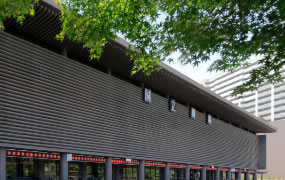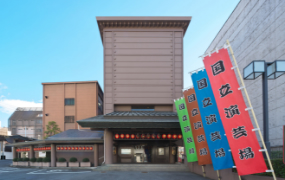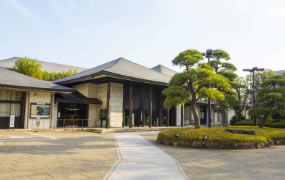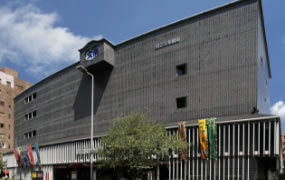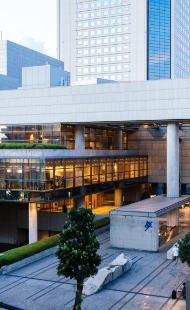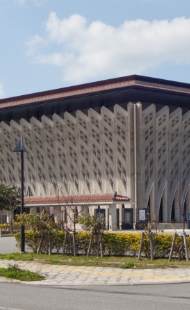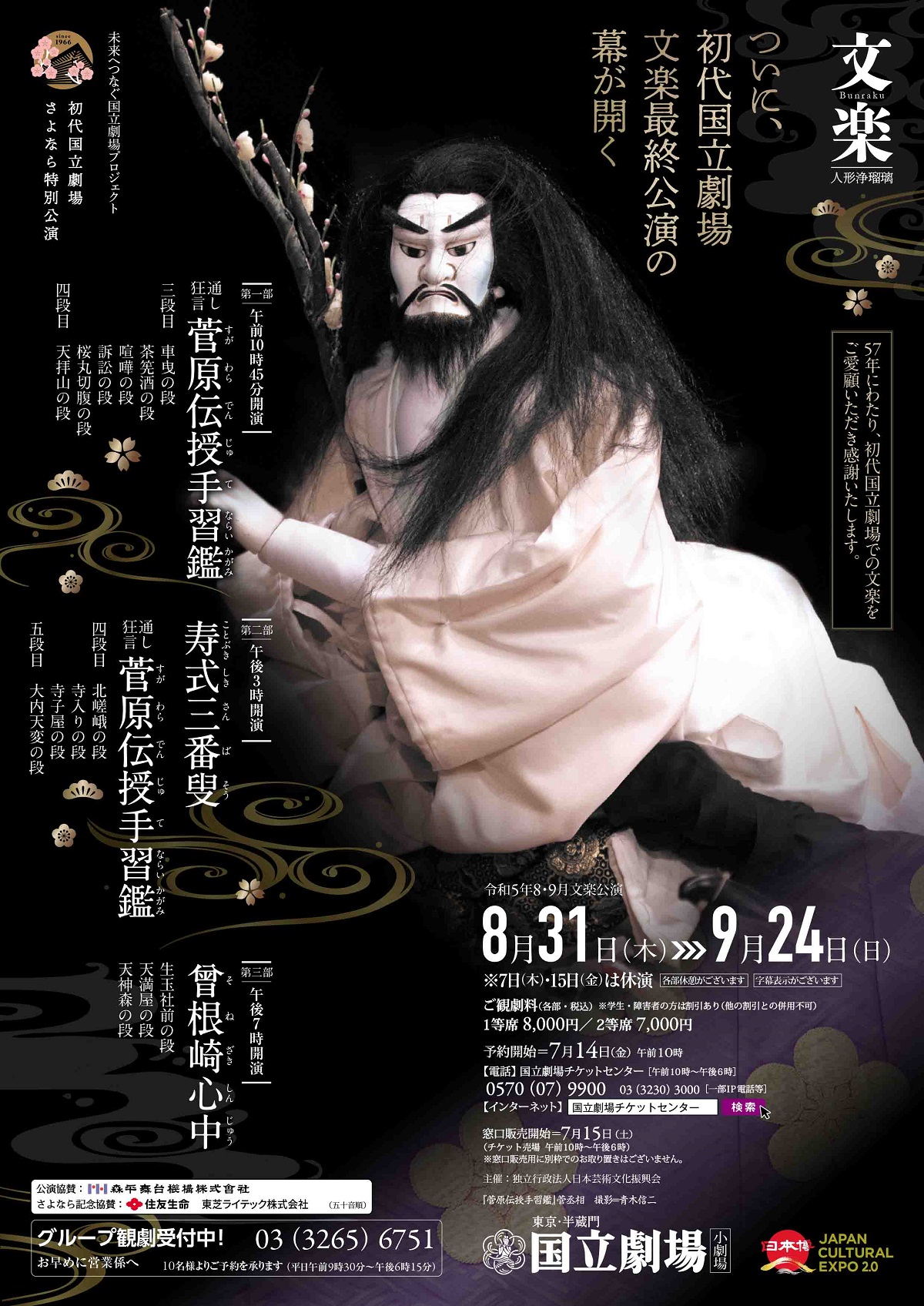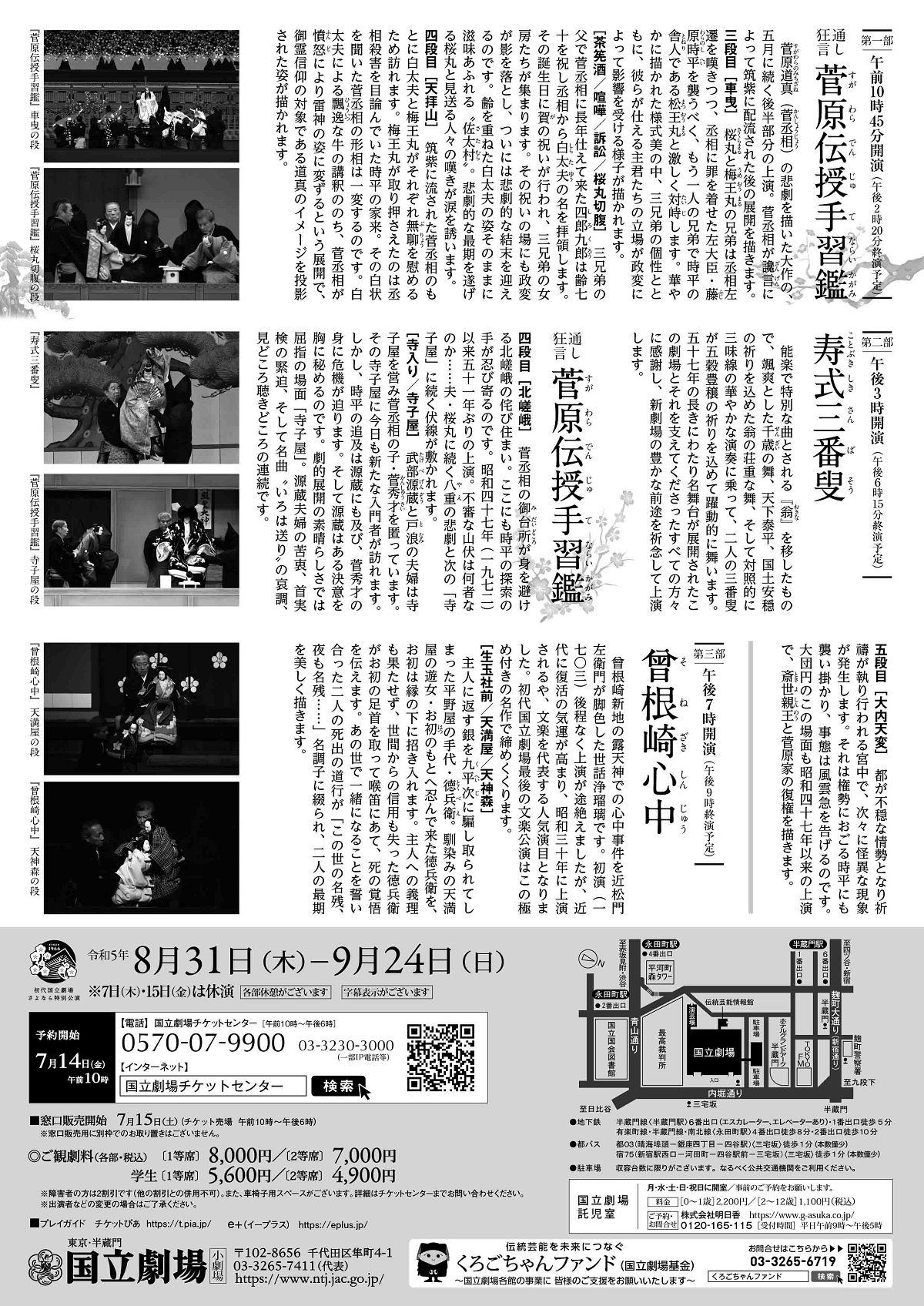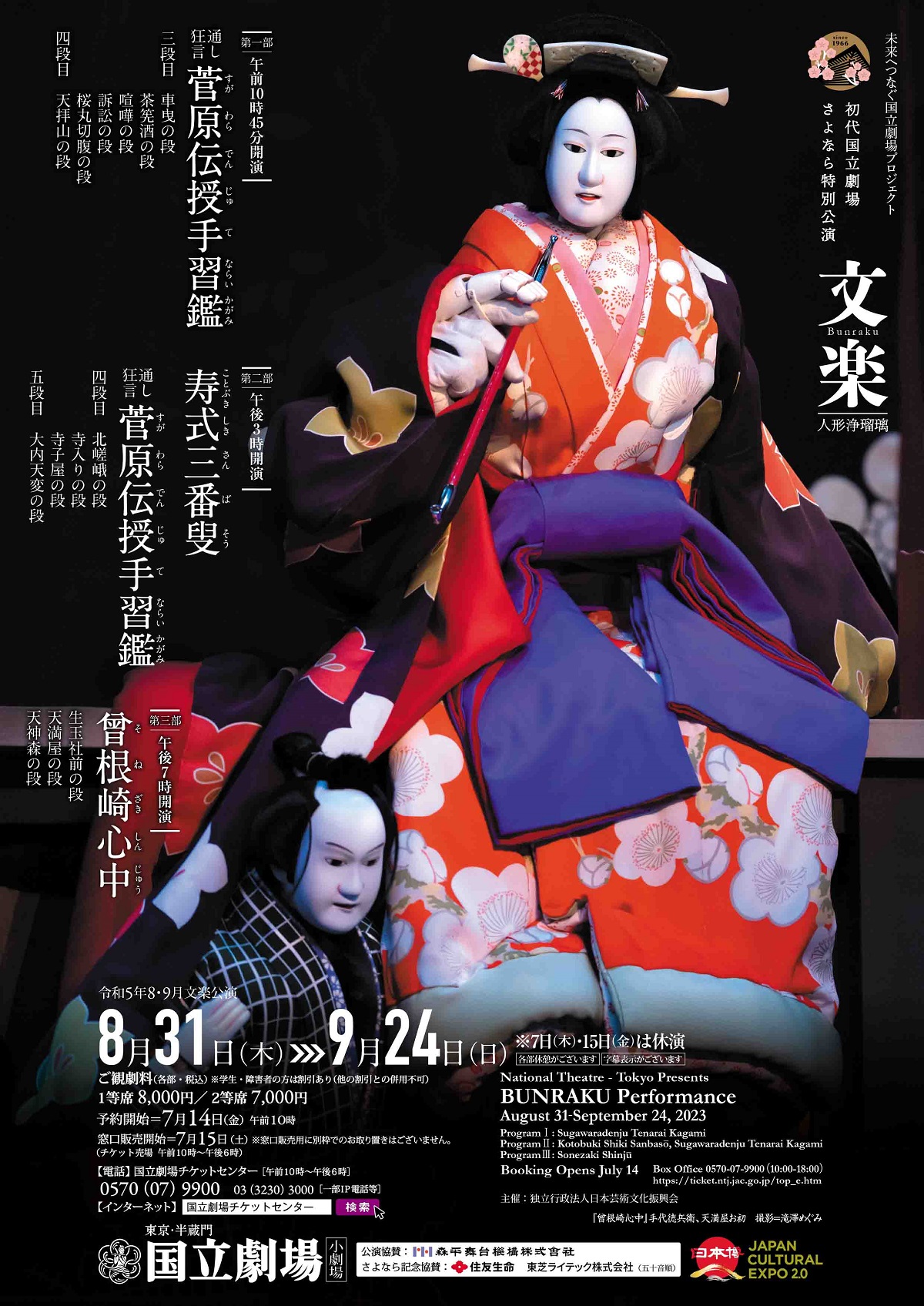- Bunraku
- National Theatre
Bunraku Performances
Bunraku Performances in August and September
Performance Dates : August 31 (Thu.) - September 24 (Sun.), 2023
No performance on 7 (Thu.) and 15 (Fri.)
Venue : National Theatre (Small Theatre)
Program Ⅰ (10:45–14:20)
Sugawara Denju Tenarai Kagami Part 3 & 4
Program II (15:00-18:15)
Kotobuki Shiki Sanbasō
Sugawara Denju Tenarai Kagami Part 4 & 5
Program III (19:00-21:00)
Sonezaki Shinjū
Ticket Prices for Each Program(tax included)
Adults: 1st Grade ¥8,000 2nd Grade ¥7,000
Students: 1st Grade ¥5,600 2nd Grade ¥4,900
Seating plan
*End times are estimates and could vary.
*Japanese audio guides are available for rent. Click here for details of audio guide.
*Subtitles: Available only in Japanese. Displayed on screen beside the stage.
*English synopsis is available. It is included in the paid Japanese brochure.
*There will be intermission.
Partner for Bunraku Performances in August and September![]() Morihei Butai Kiko Co., Ltd.
Morihei Butai Kiko Co., Ltd.
Partners for Special Farewell Performances
SUMITOMO LIFE INSURANCE COMPANY
TOSHIBA LIGHTING & TECHNOLOGY CORPORATION

Booking Opens
July 14 (Fri.), 2023
-----------------------------------------------------------------------------
Box Office
0570-07-9900 (From overseas: +81-3-3230-3000) in Japanese and English
(10:00 - 18:00)
Online Booking : https://ticket.ntj.jac.go.jp/top_e.htm
-----------------------------------------------------------------------------
Counter Sales at the Theatre
available from July 15 (Sat.)
(Business hours: 10:00 – 18:00 )
in Japanese
[Part I]
Sugawara Denju Tenarai Kagami
This is the sequel to the Act I and II of the large-scale work depicting the tragedy of Sugawara no Michizane (Kanshōjō in the play), which was presented in May. This time, the story is set in the days after Kanshōjō, the Minister of the Right, was exiled to Tsukushi (Dazaifu) due to slander.
[Kurumabiki]
Sakuramaru and Umeōmaru, the brothers, moan about the demotion of Kanshōjō. Attempting to attack Fujiwara no Shihei, the Minister of the Left who scapegoated Kanshōjō, the two fiercely face off against their brother Matsuōmaru – the remaining one of the triplet brothers who is also Shihei’s footman. Along with the individual characters of the triplets, the standpoints of their lords who have been affected by political disturbances are depicted through the stylistic beauty of this piece.
[Chasenzake / Kenka / Soshō / Sakuramaru Seppuku]
Having lived to be seventy years old, Shirokurō, the father of the triplet brothers who has long served Kanshōjō, receives the name of Shiratayū from Kanshōjō. The celebration is held on his birthday, where the wives of the three brothers mingle. However, political turmoil casts a shadow even on such a celebratory occasion, leading to a tragic ending. The scene of “Satamura” is full of delicate nuances reflecting the figure of Shirokurō, who retired to be Shiratayū. Sakuramaru’s tragedy and the grief of the people who bury him will bring the audience to tears.
[Tenpaizan]
To relieve the tedium, Shiratayū and Umeōmaru separately visit with Kanshōjō, who has been deported to Tsukushi. There, Umeōmaru seizes the retainer of Shihei who plotted to kill Kanshōjō. While hearing the retainer’s confession, Kanshōjō changes his expression. After hearing an indifferent lecture on cows given by Shiratayū, Kanshōjō transforms himself into the god of thunder in a towering rage. Depicted in this piece is the figure projecting the image of Michizane as the object of Goryō-shinkō (a Japanese folk religious belief of avenging spirits).
[Part II]
Kotobuki Shiki Sanbasō
This piece, adapted from the special Noh play Okina, consists of three parts: A gallant dance by Senzai; a solemn dance by Okina in prayer for universal piece and national tranquility; and a contrasting dynamic dance by a pair of Sanbasō, who perform to the accompaniment of brilliant shamisen music while praying for a bumper crop. With much appreciation to the current National Theatre, which has presented numerous great performances for 57 years, as well as to all the people involved so far, we present this auspicious piece in prayer for a glorious future of our new theater.
Sugawara Denju Tenarai Kagami
[Kitasaga]
This piece is set in a hermitage in Kitasaga where Kanshōjō’s wife has secluded herself. She is even caught in Shihei’s claws. Today, this scene is being performed for the first time since 1972. It depicts the tragedy of Yae following that of her husband Sakuramaru, and sets up the foreshadowing of the next scene “Terakoya.”
[Terairi / Terakoya]
Takebe Genzō and his wife Tonami are hiding Kanshōjō’s son Kanshūsai at the terakoya (village school) they run. As they welcome new students one day, Shihei meanwhile is relentless in his interrogation, which extends to Genzō, putting Kanshūsai in danger. Finally, Genzō makes a determination with a cornered look on his face. This “ Terakoya ” scene stands out in the dramatic development of the story. It is full of emotional highlights, including the mental suffering of Genzō and Tonami, the tense kubi-jikken (inspection of the head) scene, and the plaintive melodies of the musical masterpiece “Iroha Okuri.”
[Ōuchi Tenpen]
Amid the turbulent situation in the capital, a prayer service is held in the Imperial Court. There, unnatural phenomena take place one after another. Eventually, it comes down on power-wielder Shihei as well, and the situation grows tense. This scene, which progresses into the denouement, is also being presented for the first time since 1972, and depicts the reinstatement of Tokiyo Shinnō and the Sugawara family.
[Part III]
Sonezaki Shinjū
This is a Sewa Jōruri piece (a drama depicting common peoples’ lives) adapted by Chikamatsu Monzaemon, and it is themed on a double suicide at the Tsuyuno Tenjin Shrine in Sonezakishinchi. Although the performance came to a halt soon after its premiere in 1703, the desire for its revival grew among the people in modern times. As soon as it was revived in 1955, it became a popular program representative of Bunraku. The final Bunraku Performances in the original National Theatre wraps up with this widely acclaimed masterpiece.
[Ikudama Shazen / Tenmaya / Tenjin no Mori]
Hiranoya shop clerk Tokubē is tricked by Kuheiji out of some silver that was supposed to be given back to his master. Tokubē visits with his courtesan Tenmaya Ohatsu, who invites him to hide under the verandah of the house. Unable to fulfill his duty to his master, Tokubē has now turned his back on the world. He holds the ankle of Ohatsu and puts it at his throat, conveying to her his determination to die. The last journey of the couple, who have promised to get married in the next world, is beautifully depicted along with the famous rhythmic flow of words: “Farewell to the world, and farewell to the night...”


